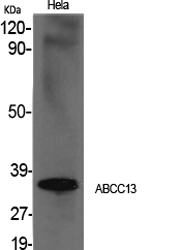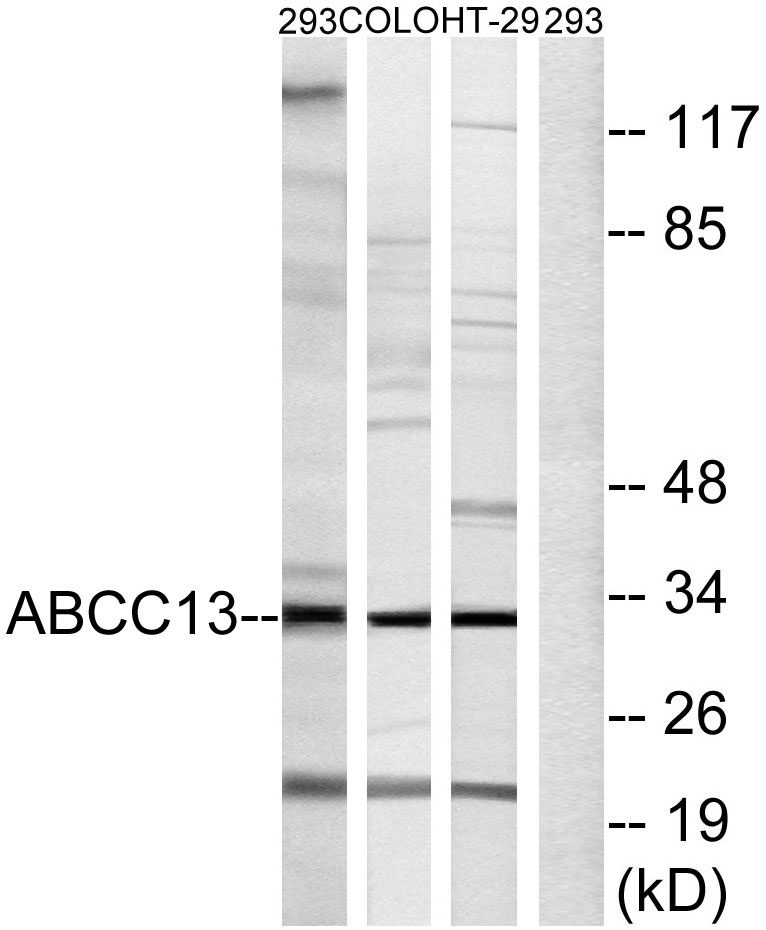ABCC13 Polyclonal Antibody
- Catalog No.:YT0048
- Applications:WB;IHC;IF;ELISA
- Reactivity:Human;Rat;Mouse;
- Target:
- ABCC13
- Gene Name:
- ABCC13
- Protein Name:
- Putative ATP-binding cassette sub-family C member 13
- Human Gene Id:
- 150000
- Human Swiss Prot No:
- Q9NSE7
- Immunogen:
- The antiserum was produced against synthesized peptide derived from human ABCC13. AA range:56-105
- Specificity:
- ABCC13 Polyclonal Antibody detects endogenous levels of ABCC13 protein.
- Formulation:
- Liquid in PBS containing 50% glycerol, 0.5% BSA and 0.02% sodium azide.
- Source:
- Polyclonal, Rabbit,IgG
- Dilution:
- WB 1:500 - 1:2000. IHC 1:100 - 1:300. ELISA: 1:40000.. IF 1:50-200
- Purification:
- The antibody was affinity-purified from rabbit antiserum by affinity-chromatography using epitope-specific immunogen.
- Concentration:
- 1 mg/ml
- Storage Stability:
- -15°C to -25°C/1 year(Do not lower than -25°C)
- Other Name:
- ABCC13;C21orf73;PRED6;Putative ATP-binding cassette sub-family C member 13
- Observed Band(KD):
- 31kD
- Background:
- ATP binding cassette subfamily C member 13 (pseudogene)(ABCC13) Homo sapiens This gene is a member of the superfamily of genes encoding ATP-binding cassette (ABC) transporters. ABC proteins transport various molecules across extra- and intra-cellular membranes. ABC genes are divided into seven distinct subfamilies (ABC1, MDR/TAP, MRP, ALD, OABP, GCN20, and White). This family member is part of the MRP subfamily, which is involved in multi-drug resistance, but the human locus is now thought to be a pseudogene incapable of encoding a functional ABC protein. Alternative splicing results in multiple transcript variants; however, not all variants have been fully described. [provided by RefSeq, Jul 2008],
- Function:
- alternative products:Experimental confirmation may be lacking for some isoforms,caution:Contains sequences related to the ABC transporters of subfamily C, but lacks Walker A, Walker B, and signature C motifs, indicating that it is a nonfunctional ABC transporter. Translation of the cDNA in a different reading frame predicts a 93 amino acid peptide with signature C and Walker B motifs, but no Walker A motif.,induction:Down-regulated by cell differentiation in certain leukemia cells.,similarity:Belongs to the binding-protein-dependent transport system permease family.,similarity:Contains 1 ABC transmembrane type-1 domain.,tissue specificity:Highest expression in fetal liver and fetal spleen. In the adult, highest levels are found in the colon ascending and transverse. Also expressed in brain, placenta, lung, liver, pancreas and ovary. In bone marrow cells, levels are several fold higher th
- Subcellular Location:
- integral component of membrane,
- Expression:
- Liver,Placenta,
- June 19-2018
- WESTERN IMMUNOBLOTTING PROTOCOL
- June 19-2018
- IMMUNOHISTOCHEMISTRY-PARAFFIN PROTOCOL
- June 19-2018
- IMMUNOFLUORESCENCE PROTOCOL
- September 08-2020
- FLOW-CYTOMEYRT-PROTOCOL
- May 20-2022
- Cell-Based ELISA│解您多样本WB检测之困扰
- July 13-2018
- CELL-BASED-ELISA-PROTOCOL-FOR-ACETYL-PROTEIN
- July 13-2018
- CELL-BASED-ELISA-PROTOCOL-FOR-PHOSPHO-PROTEIN
- July 13-2018
- Antibody-FAQs
- Products Images

- Western Blot analysis of various cells using ABCC13 Polyclonal Antibody cells nucleus extracted by Minute TM Cytoplasmic and Nuclear Fractionation kit (SC-003,Inventbiotech,MN,USA).
.jpg)
- Western Blot analysis of HT29 cells using ABCC13 Polyclonal Antibody cells nucleus extracted by Minute TM Cytoplasmic and Nuclear Fractionation kit (SC-003,Inventbiotech,MN,USA).

- Immunohistochemistry analysis of paraffin-embedded human liver carcinoma tissue, using ABCC13 Antibody. The picture on the right is blocked with the synthesized peptide.

- Western blot analysis of lysates from 293, COLO, and HT-29 cells, using ABCC13 Antibody. The lane on the right is blocked with the synthesized peptide.



